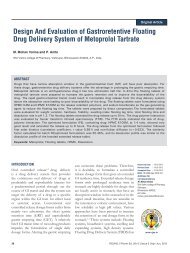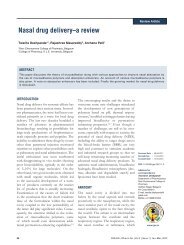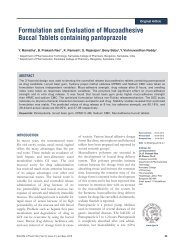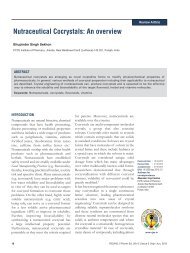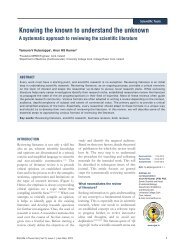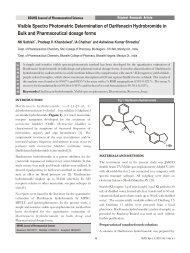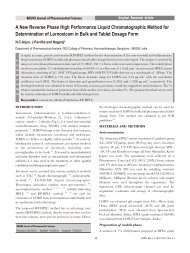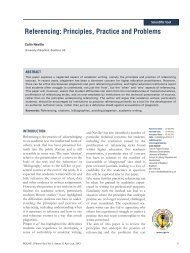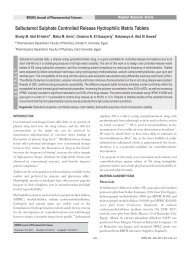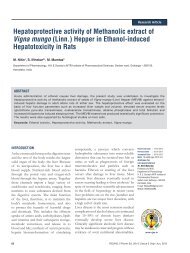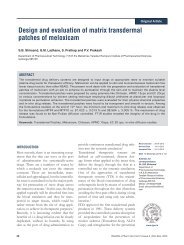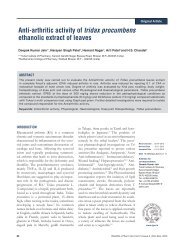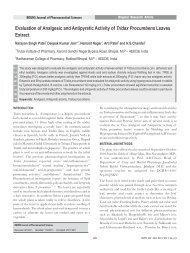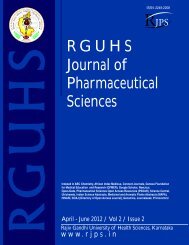Chitosan Loaded Mucoadhesive Microspheres of Gliclazide - Journal
Chitosan Loaded Mucoadhesive Microspheres of Gliclazide - Journal
Chitosan Loaded Mucoadhesive Microspheres of Gliclazide - Journal
You also want an ePaper? Increase the reach of your titles
YUMPU automatically turns print PDFs into web optimized ePapers that Google loves.
Area Under Curve method (Method C)<br />
Malipatil S.M et al./ Validated UV-Spectrophotometric Estimation <strong>of</strong> Entecavir in Bulk and Formulations<br />
This method is applicable when there is no sharp peak or<br />
when broad spectra are obtained. It involves the calculation <strong>of</strong><br />
integrated value <strong>of</strong> absorbance with respect to the wavelength<br />
between two selected wavelengths λ 1 and λ 2.<br />
Area calculation<br />
processing item calculates the area bound by the curve and the<br />
horizontal axis. The horizontal axis is selected by entering<br />
wavelength range over which the area has to be calculated.<br />
This wavelength range is selected on the basis <strong>of</strong> repeated<br />
observations so as to get the linearity between area under<br />
10<br />
curve and concentration. For the selection <strong>of</strong> analytical<br />
wavelength, 10 μg/ml working standard solution was<br />
prepared by appropriate dilution <strong>of</strong> standard stock solution in<br />
double distilled water and double distilled water was used as<br />
blank solution. This solution was scanned in the spectrum<br />
mode from 400 nm to 200 nm (Fig. 4). From the spectra <strong>of</strong><br />
drug, area under the curve in the range <strong>of</strong> 258.0-248.0 nm<br />
was selected for the analysis. The calibration curve was<br />
plotted as AUC against concentration <strong>of</strong> standard stock<br />
solution (Graph 3). By using the calibration curve, the<br />
concentration <strong>of</strong> the sample solution can be determined.<br />
ESTIMATION OF ENTECAVIR FROM TABLET<br />
DOSAGE FORMS<br />
For the estimation <strong>of</strong> Entecavir in tablet formulation by three<br />
methods, 25 tablets <strong>of</strong> each brand were weighed and<br />
triturated to fine powder. Tablet powder equivalent to 25mg<br />
<strong>of</strong> Entecavir was weighed and dissolved and further dilution<br />
was carried out with quantity sufficient <strong>of</strong> double distilled<br />
water. This was then filtered through the Whatmann filter<br />
paper no. 41 to get the stock solution <strong>of</strong> concentration 100<br />
Table 2: Accuracy and precision data for the developed methods<br />
Level<br />
Method A<br />
Range (µg/ml)<br />
a<br />
S.D<br />
b<br />
% RSD<br />
LQC 2.0-4.0 0.0004 0.3071<br />
MQC 8.0-10.0 0.0011 0.2446<br />
HQC<br />
Method B<br />
16.0-18.0 0.0008 0.0969<br />
LQC 2.0-4.0 0.00007 0.2551<br />
MQC 8.0-10.0 0.00004 0.3718<br />
HQC<br />
Method C<br />
16.0-18.0 0.00003 0.7774<br />
LQC 2.0-4.0 0.000053 0.00659<br />
MQC 8.0-10 0.000149 0.006609<br />
HQC 16.0-18.0 0.000035 0.000839<br />
a b<br />
standard deviation, % relative standard deviation LQC Lower<br />
Quantifiable Concentration, MQC Middle Quantifiable<br />
Concentration, HQC Higher Quantifiable Concentration (Each<br />
value is a result <strong>of</strong> six separate determinations)<br />
μg/ml. Further this stock solution was suitably diluted to get<br />
10 μg / ml and these samples were analysed using proposed<br />
methods (Table 4).<br />
ANALYTICAL VALIDATIONS<br />
Specificity and Selectivity<br />
Entecavir solutions (10 μg/ml) were prepared in double<br />
distilled water along with and without common excipients<br />
[lactose monohydrate, microcrystalline cellulose,<br />
crospovidone, povidone, and magnesium stearate, titanium<br />
Table 3: Results <strong>of</strong> intermediate precision study<br />
Concentration Inter-day repeatability Intra-day repeatability Inter-instrument*<br />
(in µg/ml) % RSD (N=8) % RSD (N=8) repeatability % RSD (N=8)<br />
Day 1 Day 2 Day 3<br />
Method A<br />
2 0.7932 0.6903 0.4764 0.50 0.73<br />
10 0.1363 0.2140 0.098 2 0.11 0.29<br />
18<br />
Method B<br />
0.0752 0.1181 0.0767 0.10 0.15<br />
2 0.1234 1.3137 1.7788 0.1238 0.62<br />
10 0.2885 3.4077 2.2308 0.2880 0.55<br />
18<br />
Method C<br />
0.9855 1.0137 1.2948 0.9855 0.49<br />
2 0.0279 0.0203 0.0130 0.013 0.021<br />
10 0.0602 0.0466 0.0029 0.002 0.008<br />
18 0.0059 0.0025 0.0026 0.001 0.002<br />
* Instrument 1: Shimadzu UV-Visible spectrophotometer 1700, Instrument 2: Systronic-118 UV-Visible spectrophotometer<br />
113<br />
RJPS, Jul - Sep, 2011/ Vol 1/ Issue 2



